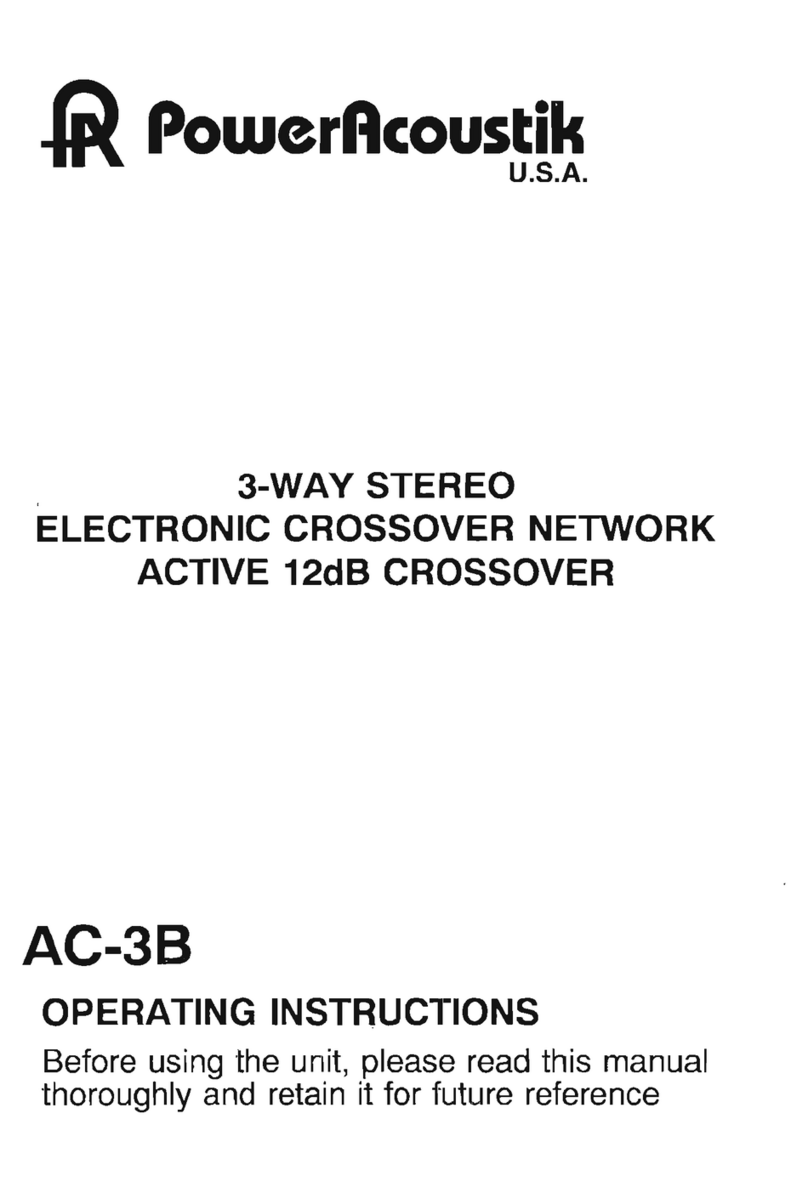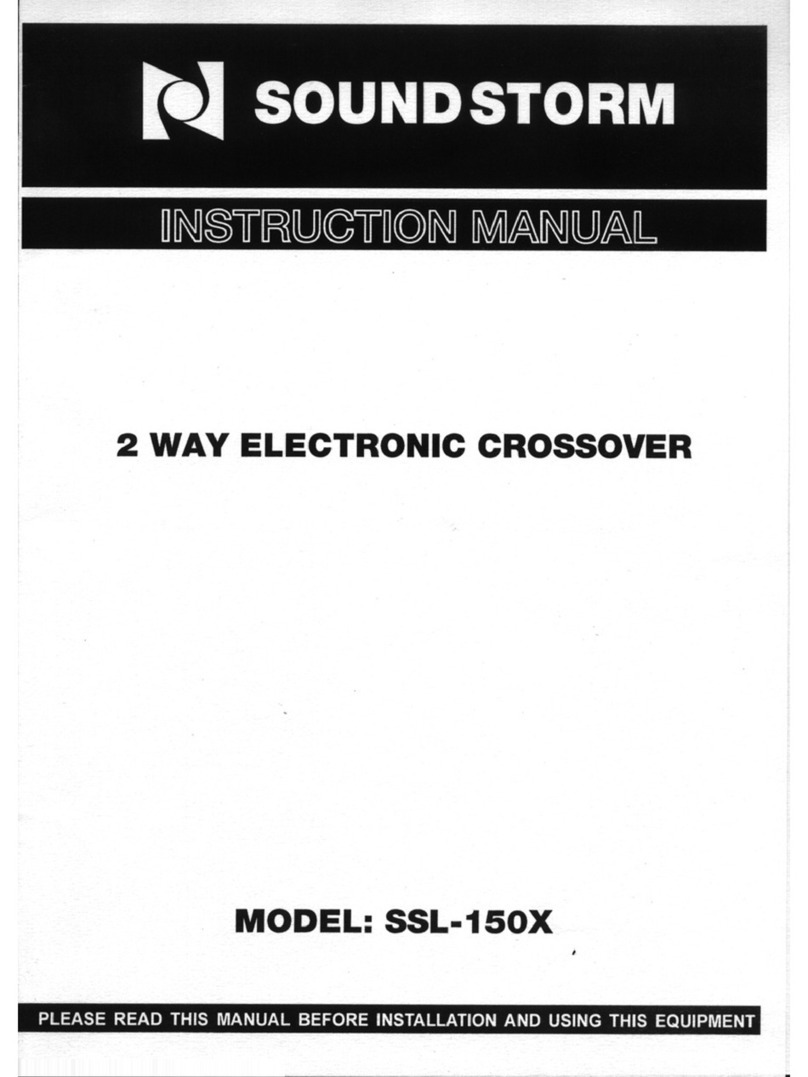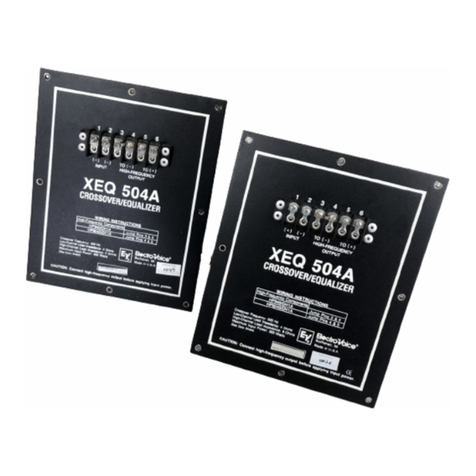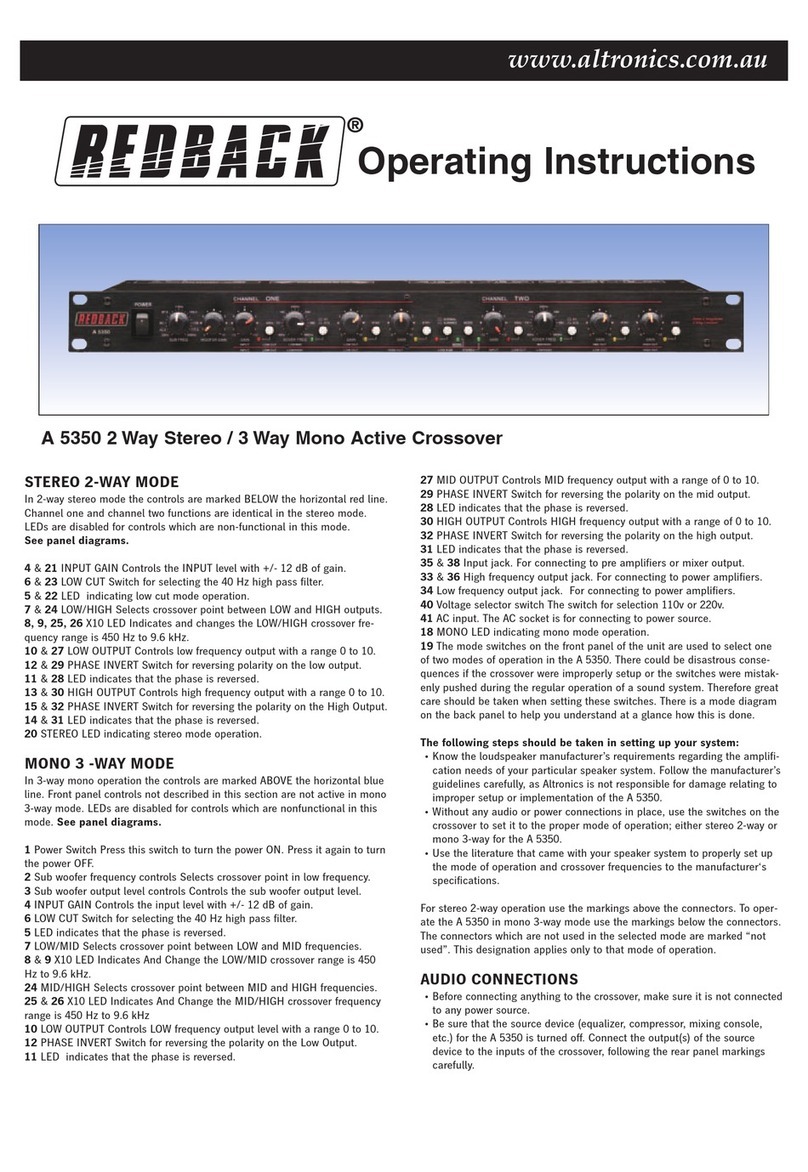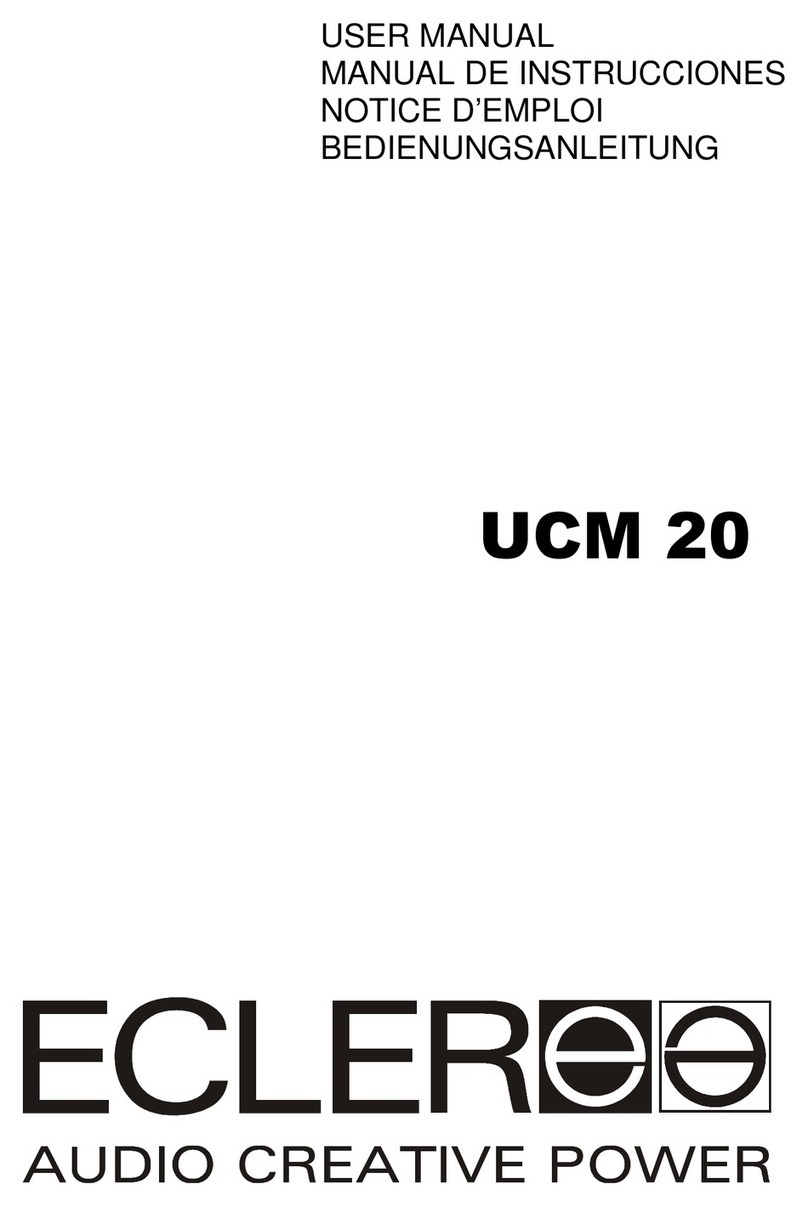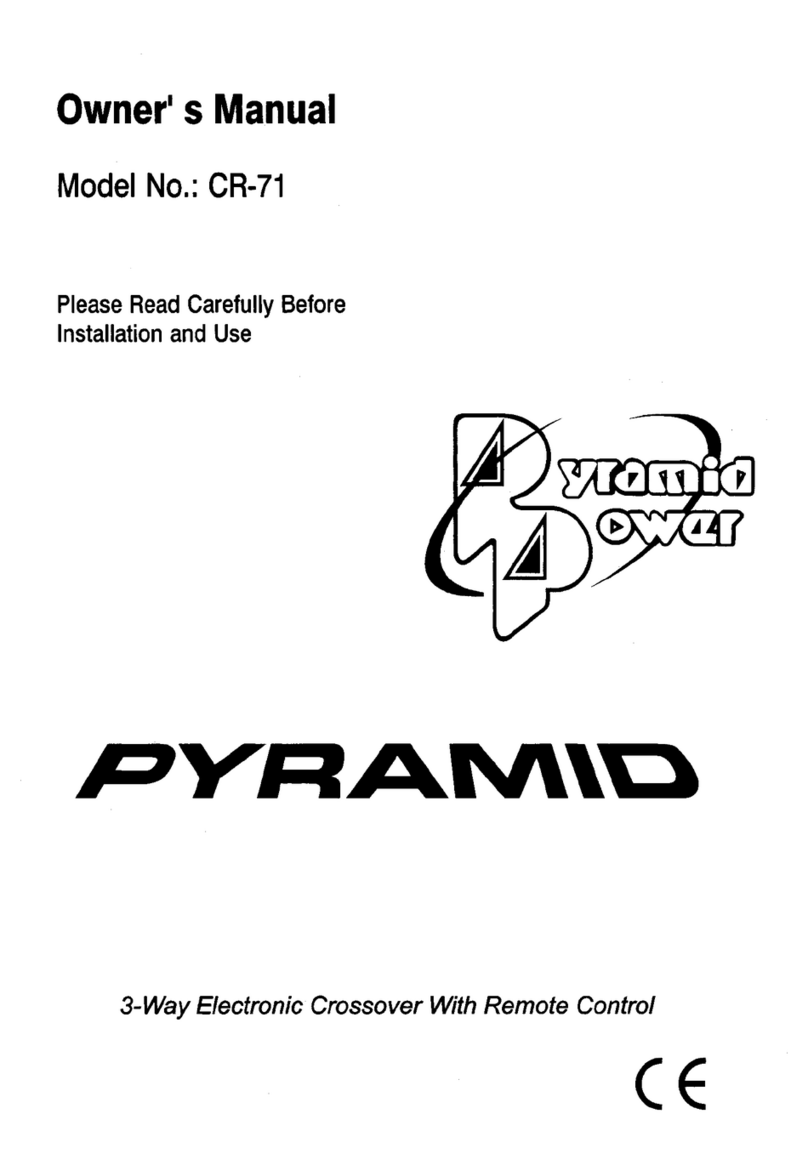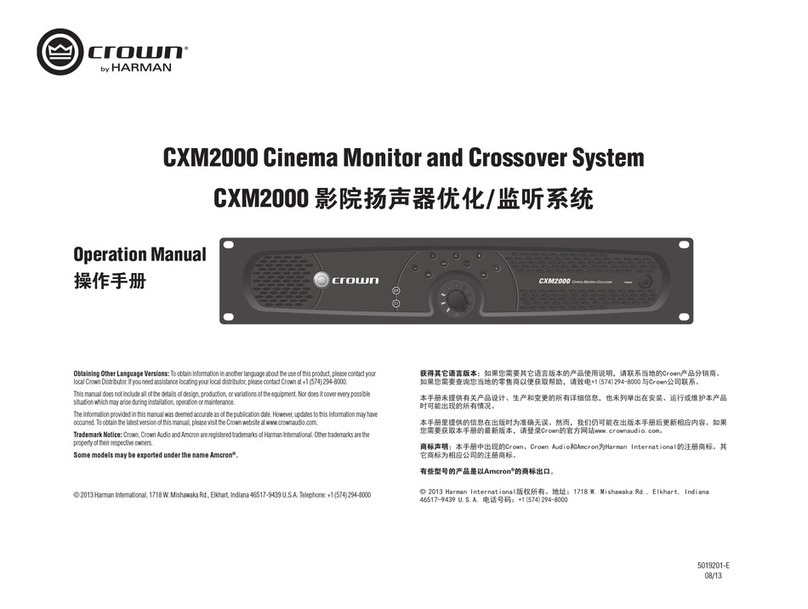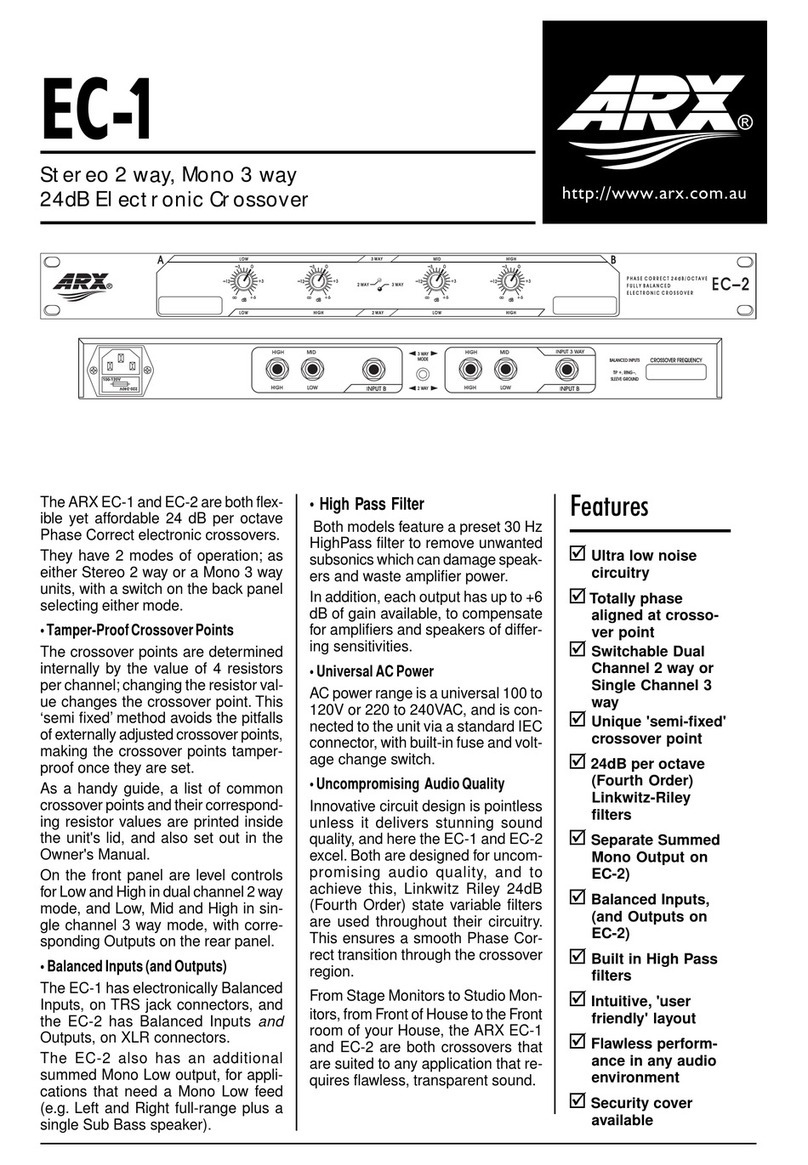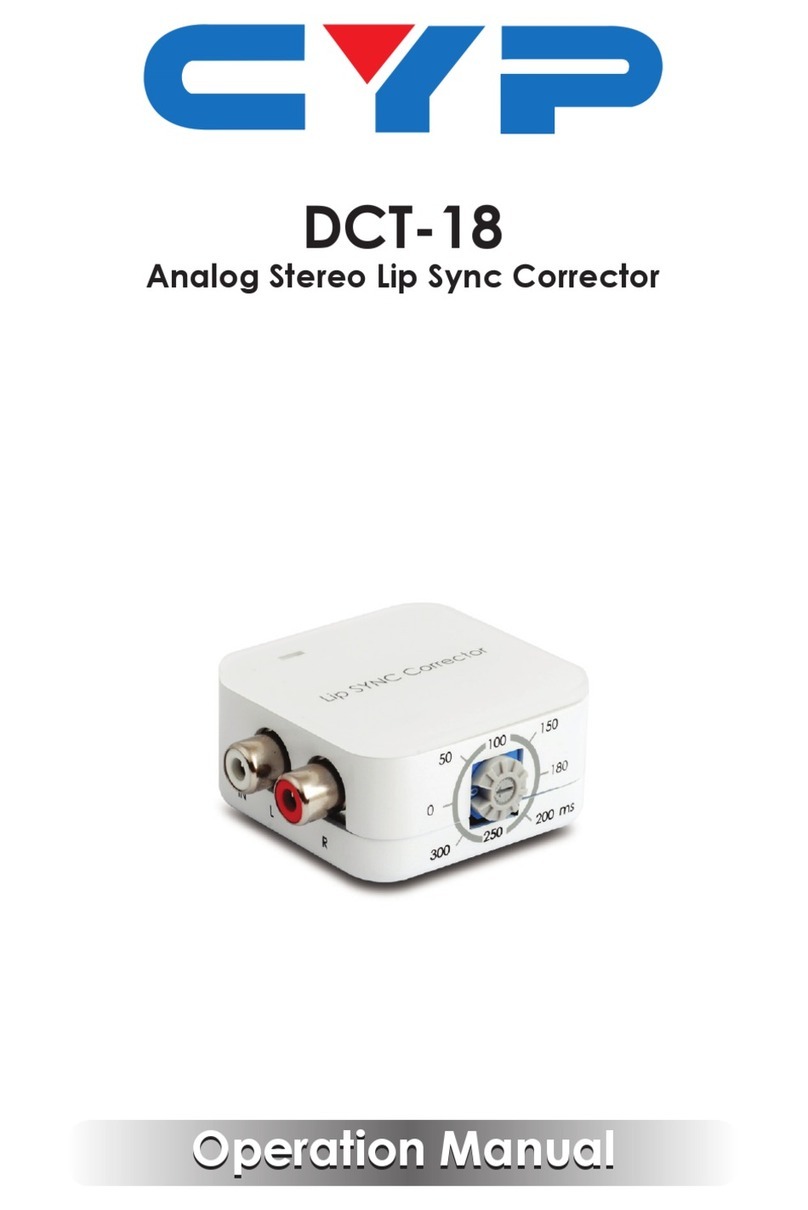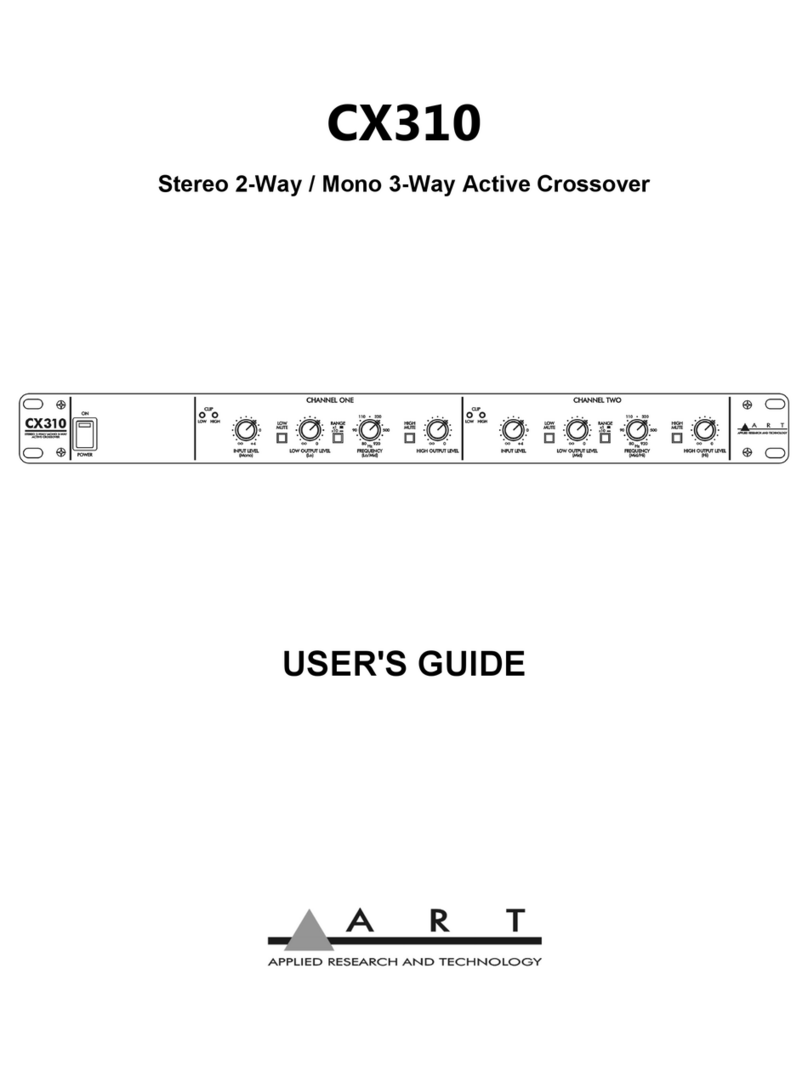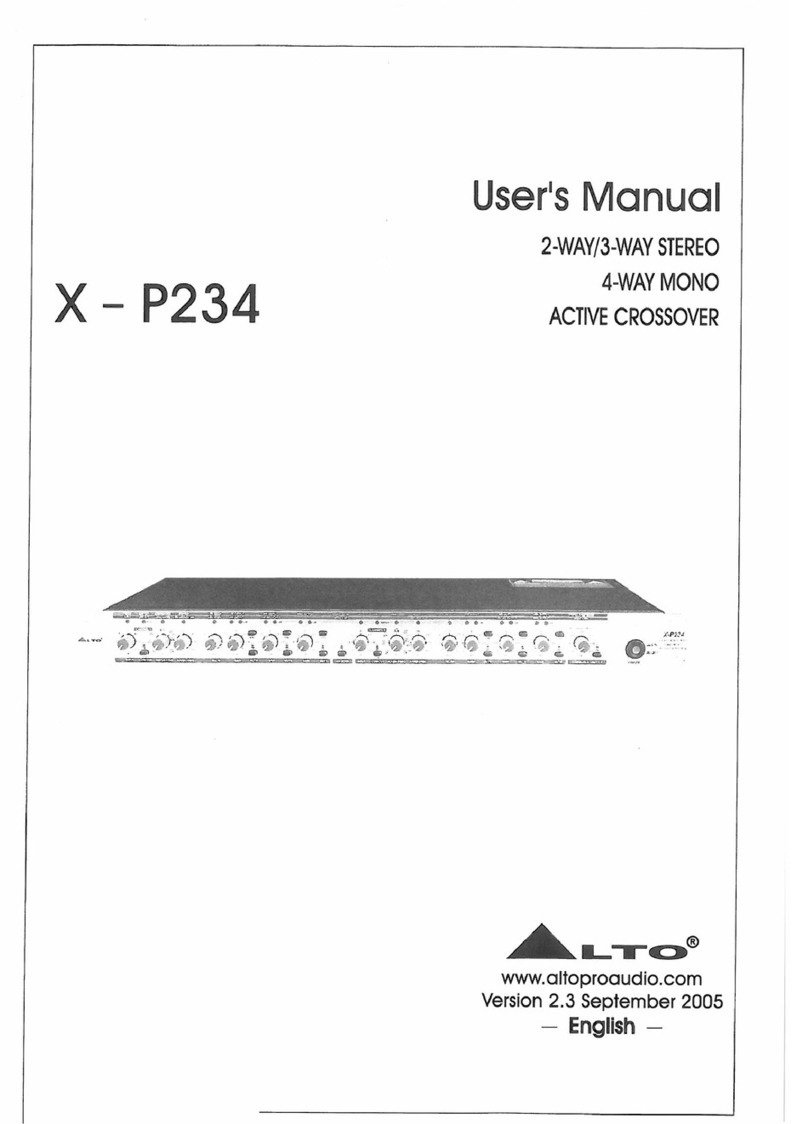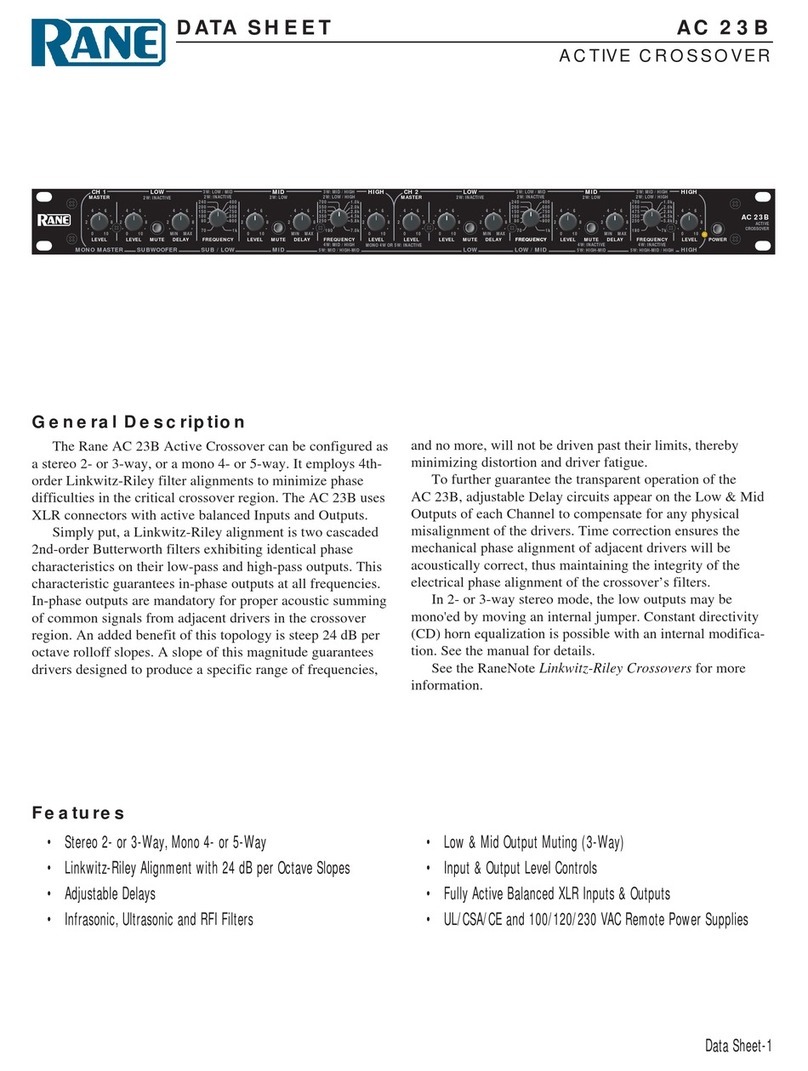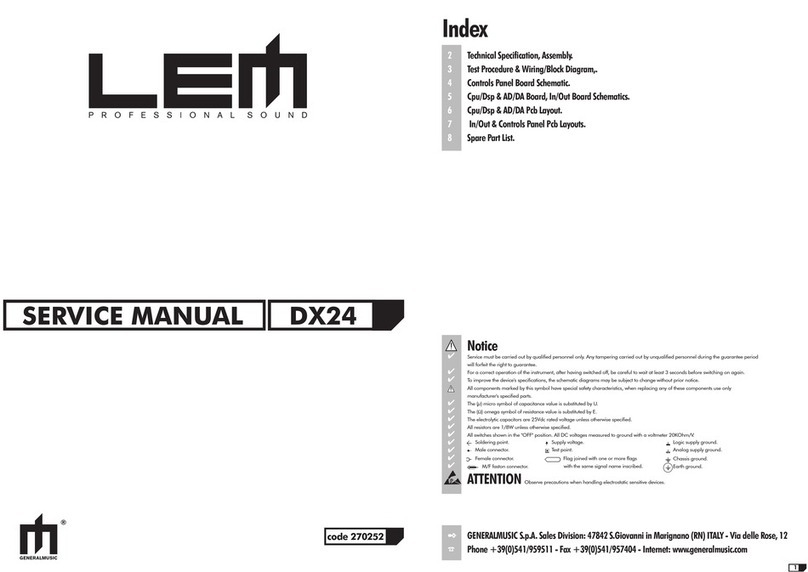Linear Power XO-1 Programming manual

™
F O R T H E L O V E O F M U S I C
MODEL XO-1©
(1983-MSRP $149.00)
OWNER'S MANUAL AND
INSTALLATION GUIDE
ACTIVE ELECTRONIC PHASE COHERENT
CROSSOVER
INTRODUCTION
The XO-1© is a fully programmable electronic crossover, which allows a
frequency change via a replaceable resistor network. Any frequency of crossover
can be selected between 32Hz and 12,500Hz in 5% increments. The network
can be easily inserted or removed from the special "quick change" I.C. latch
socket. The XO-1© makes possible both bi-amp and tri-amp systems with a
separate channel of amplification for each driver. A signal amplifier system
requires that the amplifier reproduce the full audible frequency range and power
multiple drivers through a passive dividing network. In an active crossover
system, one amplifier channel powers only one driver and must reproduce only a
part of the frequency range. The three main advantages of an active (electronic)
crossover are;
1. That a high order of inter-modulation distortion reduction can be realized due
to non-interaction between high and low frequencies, yielding improved clarity.
2. The elimination of the passive crossover itself. The elements of the crossover
absorb power from the amplifier and may cause distortion. In addition, the
capacitors and coils of a crossover create a reactive load that is difficult for an
amplifier to drive compared to the more purely resistive load of the driver.
3. A passive crossover system requires approximately 3dB more power than an
active crossover system. In other words, an active crossover system requires half
the total power of a passive system.
© 2008 Linear Power, Inc. - ALL RIGHTS RESERVED
LINEAR POWER™ is a trademark of Linear Power, Inc.
1

TECHNICAL DESCRIPTION
The XO-1© uses FET input operational amplifiers which are well known for their
reliability and freedom from slew induced distortion. The XO-1© filter stages
employ two-pole, state variable design. A unique ultrasonic converter supplies a
negative 14 volts to the circuitry which provides freedom from external electrical
interference as well as accounting for the unusually high output voltage.
A heavy aluminum extrusion and rigid endplates combine to form a rugged
unitized chassis. All construction and assembly is performed in-house and each
unit is fully tested, inspected, and re-tested before shipping.
INSTRUCTIONS
Read the following instructions completely through. If it appears too complicated,
we recommend that you have an authorized LINEAR POWER™ dealer do the
work.
IMPORTANT !!!
THE FREQUENCY CHIP MUST BE PROPERLY INSTALLED AND LOCKED
FIRMLY IN POSISTION PRIOR TO OPERATION IN ORDER TO PREVENT
THE POSSIBILITY OF SEVERE SYSTEM DAMAGE.
MOUNTING
As the XO-1© contains no user operated controls, the best mounting location is
close to the amplifiers. The XO-1© should be mounted in a position such that the
access plate (the one with no wires) can be removed for easy frequency change,
and that the output fan-outs can plug directly into the amplifiers. To prevent
electrical interference it is advisable that phono extensions be kept to the
minimum lengths necessary.
In some trunk mount applications, a good method for mounting bi-amp and tri-
amp systems is to fashion a mounting plate made of 1/2 to 1/4 inch plywood and
attach it to the back of the rear seat in the trunk. This will provide a secure base
for attaching XO-1© and amplifiers and will make drilling multiple mounting holes
through sheet metal unnecessary.
© 2008 Linear Power, Inc. - ALL RIGHTS RESERVED
LINEAR POWER™ is a trademark of Linear Power, Inc.
2

WIRING
Refer to the diagrams that follow. NOTE: ALL CONNECTIONS MUST BE
ELECTRICALLY AND PHYSICALLY SOUND. AVOID RUNNING POWER
CABLES AND SIGNAL CABLES ALONGSIDE ONE ANOTHER.
1. POWER
Your XO-1© can be connected in one of several ways:
A. Connect the XO-1© red wire to the power antenna wire of the music source if
the power antenna wire is "hot" when the source is on. The power antenna wire
is turned off on some units when the antenna is raised up all the way or when the
tape selection is used. For these units, and for units with no power antenna
wires, use the alternate methods "B" or "C".
B. The XO-1© red wire can be connected along with the amplifier remote turn-on
(trigger) wire to a CS-1 current sense adaptor (available as an accessory through
an authorized LINEAR POWER dealer).
C. The XO-1© red wire can be connected through a toggle switch (current rating
is not important) to the fuse panel. IMPORTANT: THE XO-1© POWER WIRE
SHOULD NOT BE DIRECTLY CONNECTED TO A SOURCE OF POWER
WHICH WILL BE HOT EVEN WHEN THE IGNITION IS TURNED OFF, AS
BATTERY DRAIN MAY OCCUR AFTER AN EXTENDED PERIOD.
MAIN GROUND
Connect the black ground wire to a car chassis ground, preferably to the same
point at which the amplifiers are grounded.
2. INPUT
Connect the right and left inputs on the XO-1© to the right and left outputs from
the music source. If the output of the music source is high level (designed to
connect directly to a speaker) obtain a set of high level adaptor plugs from your
LINEAR POWER dealer and follow the enclosed directions.
3. OUTPUTS (BI-AMP)
Low Frequency:
Connect the right and left low frequency outputs from the XO-1© to the right and
left inputs on the low frequency amplifier. The low frequency speakers (woofers)
can then be connected to the output of the low frequency amplifier.
High Frequency:
Connect the right and left high frequency outputs from the XO-1© to the right and
left inputs on the high frequency amplifier. (See DIAGRAM A for
interconnections.)
© 2008 Linear Power, Inc. - ALL RIGHTS RESERVED
LINEAR POWER™ is a trademark of Linear Power, Inc.
3

4. OUTPUTS
(Mono-bridge subwoofer)
In a mono subwoofer system, the low frequency amplifier's outputs are strapped
together (bridged) by the XO-1© to sum the power of both channels into one to
drive a single 8 ohm woofer. In this configuration, both of the speaker ground
wires are unused and should be taped and dressed away from the other wiring.
The woofer can then be connected directly across the right and left speaker
output "hot" wires from the low frequency amplifier by attaching the green wire to
the woofer positive terminal and the grey wire to the negative terminal.
Follow DIAGRAM B for high and low frequency connections and check to see
that the mono-stereo switch inside the XO-1© is in the "mono" position.
CAUTION: WHEN BRIDGING AN AMPLIFIER, THE SPEAKER IMPEDANCE
MUST NOT BE LESS THAN 8 OHMS, AND MUST NOT BE GROUNDED AT
ANY POINT.
5. OUTPUTS
(Tri-amp System)
In a tramp system, individual amplifiers are used for bass, midrange, and treble
frequencies. In this configuration, two XO-1's© are "cascaded" in order to obtain
the third frequency range. (See DIAGRAM C for interconnections.)
All crossovers that are not PHASE COHERENT will cause some phase shift at
the crossover point. In a three way system with two crossovers, there will be
phase shift at both crossover points. By reversing the electrical phase of the mid
range driver, relative to the woofer and tweeter phase, this phase shift will be
compensated so that the system will be acoustically in phase, though electrically
out of phase. In most cases the system will sound better with the phase of the
mid range drivers reversed. Although this sound complicated, it is really quite
simple to do. After your system is installed and operating, reverse the leads to
your mid range drivers, so that the positive (+) lead from the amp is connected to
the negative (-) terminal on you speaker, and the negative (-) terminal to the
positive (+) lead on the amp. Listen to the system, then return the leads to their
original positions and listen again. Connect the leads in whatever position
achieved the best sound.
© 2008 Linear Power, Inc. - ALL RIGHTS RESERVED
LINEAR POWER™ is a trademark of Linear Power, Inc.
4

OPERATION/ADJUSTMENT/USE
1. CROSSOVER FREQUENCY SELECTION
A. Remove the access plate on the XO-1©. IMPORTANT: IT IS NECESSARY
THAT ALL POWER TO THE SYSTEM BE TURNED OFF PRIOR TO NETWORK
REMOVAL/INSERTION.
WE REPEAT THE WARNING: DAMAGE TO YOUR SPEAKERS CAN BE
CAUSED BY REMOVING THE RESISTOR NETWORK WHEN THE SYSTEM IS
TURNED ON!
B. Release latch on socket (lever up-release, Lever down-lock).
C. Carefully insert network.
D. Lock the network in the socket. NOTE: CHECK TO SEE THAT THE "STEREO
- MONO" SWITCH IS IN THE CORRECT POSITION.
E. Access plate can now be replaced.
SYSTEM ADJUSTMENT/USE- Recheck all wiring and connections and apply
power to system. Set all tone controls to "flat" (no cut or boost) position and
adjust volume to a comfortable level. Select a variety of program material,
preferably music that you know to be fairly accurate and containing deep bass as
well as high treble passages.
Increase volume of music source to approximately 3/4 of maximum. Adjust
variable gain on bass amplifier slowly clockwise just to the point where audible
distortion becomes noticeable, then turn gain control counterclockwise slightly.
Adjust the gain control on the midrange amplifier until you obtain balance to the
bass tones. Follow the same procedure for adjusting the gain of the treble
amplifier. Proper tonal balance will require some careful listening and
readjustment.
Volume can then be controlled by the music source volume control.
CROSSOVER FREQUENCY SELECTION
Selection of the proper crossover frequency depends on the driver selected and
the way in which they are used. For subwoofer operation, crossover frequencies
between 80 and 150 Hertz are generally preferred. For use between separate
drivers of a two or three way system, there is much more variance in the potential
choice of crossover frequencies. If a tweeter, say, has a response of 1200 to
22,000 Hertz, and a woofer a response of 28 to 2400 Hertz, the overlap area
© 2008 Linear Power, Inc. - ALL RIGHTS RESERVED
LINEAR POWER™ is a trademark of Linear Power, Inc.
5

would be between 1200 and 2400 Hertz (the tweeter's lower end and the
woofer's upper end). The difference between these two frequencies is ONE
octave. (Octaves are logarithmic, meaning that each octave is double the
frequency in Hertz of the previous octave. So, if 20 to 40 Hertz is the first octave,
then 40 to 80 Hertz is the second octave.) The proper crossover choice is usually
about half of the octave difference of the overlap area. In the case above, since
the overlap area is one octave, the crossover point would be at one half octave,
or 1800 Hertz.
SERVICE OR REPAIR
To obtain modification, service or repair, please contact our ONLY Authorized
LINEAR POWER™ Product Service Center:
T.I.P.S. INC.
3455 Lanell lane, Pearl, MS 39208
(601) 932-8477
E-mail: [email protected]
© 2008 Linear Power, Inc. - ALL RIGHTS RESERVED
LINEAR POWER™ is a trademark of Linear Power, Inc.
6

SPECIFICATIONS
XO-1©
Output Level: 0 to 5 volts
Total Harmonic
Distortion: 0.05% maximum
0.01% typical
Inter-modulation Distortion: 0.01% maximum
Input Impedance: 10,000 ohms
Gain: Unity (Input = Output)
Frequency Response: +1dB 4 Hz to 250 KHz
Current Draw: 25 mA maximum
Crossover Points:
50 Hz to 6 KHz in
1/3 octave steps
Crossover Slope: 12dB per octave
© 2008 Linear Power, Inc. - ALL RIGHTS RESERVED
LINEAR POWER™ is a trademark of Linear Power, Inc.
7
Table of contents
